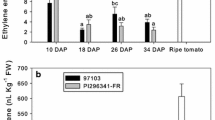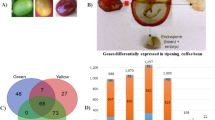Abstract
Coffee quality is strongly influenced by a great number of factors, among which the fruit ripening stage at harvest time has a major influence on this feature. Studies comprising ethylene production and the regulation of ethylene biosynthesis genes during the ripening process indicate that ethylene plays an important role on coffee fruit ripening. Coffee early cultivars usually show a more uniform ripening process although little is known about the genetic factors that promote the earliness of ripening. Thus, in order to better understand the physiological and genetic factors involved in the regulation of ripening time, and consequently ripening uniformity, this study aimed to analyze ethylene and respiration patterns during coffee ripening, as well as to analyze ACC oxidase, an ethylene biosynthesis enzyme, gene expression, in fruits of early (Catucaí 785-15) and late (Acauã) coffee cultivars. Coffee fruits were harvested monthly from 124 days after flowering (end of February), until complete maturation (end of June). Dry matter, moisture content, color, respiratory rate and ethylene production analysis were performed. In silico analysis identified a coffee ACC oxidase gene (CaACO-like) and its expression was analyzed by real-time PCR. Dry matter and relative water content constantly increased and gradually decreased, respectively, during fruit ripening, and the color analysis enabled the observation of the earliness in the ripening process displayed by Catucaí 785-15 and its higher fruit ripening uniformity. The results obtained from the CaACO-like expression analysis and respiration and ethylene analysis suggest that the differences in ripening behavior between the two coffee cultivars analyzed in this study may be related to the differences in their capacity to produce ethylene, with fruits of Catucaí 785-15 and Acauã showing a typical and an attenuated climacteric phase, respectively, which may have lead to differences in their ripening time and uniformity.







Similar content being viewed by others
References
Abdi N, Holforda P, McGlassona WB, Mizrahib Y (1997) Ripening behaviour and responses to propylene in four cultivars of Japanese type plums. Postharvest Biol Tech 12:21–34
Barreto HG, Lazzari F, Sagio SA, Chalfun-Junior A, Paiva LV, Benedito VA (2012) In silico and quantitative analyses of the putative FLC-like homologue in coffee (Coffea arabica L.). Plant Mol Biol Rep 30:29–35
Barsalobres-Cavallari CF, Severino FE, Maluf MP, Maia IG (2009) Identification of suitable internal control genes for expression studies in Coffea arabica under different experimental conditions. BMC Mol Biol 10:1–11
Biale BJ, Young ER, Olmstead AJ (1954) Fruit respiration and ethylene production. Plant Physiol 29:168–174
Carvalho CHS (2008) Cultivares de Café: origem, características e recomendações, Embrapa Café, Brasilia
Carvalho GR, Mendes ANG, Carvalho LF, Bartholo GF (2003) Eficiência do ethephon na uniformização e antecipação da maturação de frutos de cafeeiro (Coffea arabica L.) e na qualidade da bebida. Cienc Agrotec 27:98–106
Chang S, Puryear J, Cairney J (1993) A simple method for isolating RNA from pine trees. Plant Mol Biol 11:113–116
DaMatta FM, Ronchi CP, Maestri M, Barros RS (2007) Ecophysiology of coffee growth and production. Braz J Plant Physiol 19:485–510
Davis AP, Tosh J, Ruch N, Fay MF (2011) Growing coffee: Psilanthus (Rubiaceae) subsumed on the basis of molecular and morphological data; implications for the size, morphology, distribution and evolutionary history of Coffea. Bot J Lin Soc 167:357–377
De Castro RD, Marraccini P (2006) Cytology, biochemistry and molecular changes during coffee fruit development. Braz J Plant Physiol 18:175–199
El-Sharkawy I et al (2007) Isolation and characterization of four ethylene signal transduction elements in plums (Prunus salicina L.). J Exp Bot 58:3631–3643
Fazuoli LC et al (2008) Cultivares de café arábica de baixo porte. In: Carvalho CHS (ed) Cultivares de Café: origem, características e recomendações. Embrapa Café, Brasilia, pp 157–224
Geromel C et al (2006) Biochemical and genomic analysis of sucrose metabolism during coffee (Coffea arabica) fruit development. J Exp Bot 57:3243–3258
Giovannoni JJ (2004) Genetic regulation of fruit development and ripening. Plant Cell 16:170–180
International Coffee Organization (ICO) (2012) Trade Statistics http://www.ico.org/trade_statistics.asp?section=Statistics. Accessed 05 January 2013
Johnson PR, Ecker JR (1998) The ethylene gas signal transduction pathway: a molecular perspective. Ann Rev Genet 32:227–254
Kesy J, Wilmowicz E, Maciejewska B, Frankowski K, Glazinska P, Kopcewicz J (2011) Independent effects of jasmonates and ethylene on inhibition of Pharbitis nil flowering. Acta Physiol Plant 33:1211–1216
Kosiyachinda S, Young RE (1975) Ethylene production in relation to the initiation of respiratory climacteric in fruit. Plant Cell Physiol 16:595–602
Lelievre JM, Latche A, Jones B, Bouzayen M, Pech JC (1997) Ethylene and fruit ripening. Physiol Plant 101:727–739
Lima AA, Sagio SA, Chalfun-Junior A, Paiva LV (2011) In silico characterization of putative members of the coffee (Coffea arabica) ethylene signaling pathway. Genet Mol Res 10:1277–1289
Lin CT, Lin MT, Shaw JF (1997) Cloning and characterization of a cDNA for 1-aminocyclopropane-1-carboxylate oxidase from papaya fruit. J Agr Food Chem 45:526–530
Marin-Lopez SM, Arcila PS, Montoya RCE, Oliveros TCE (2003) Cambios físicos y durante la maduración del fruto de café (Coffea arabica L. var. Colombia). Cenicafé 54:208–225
McMurchie EJ, McGlasson WB, Eaks IL (1972) Treatment of fruit with propylene gives information about the biogenesis of ethylene. Nature 237:235–236
Nogueira AM, Carvalho SP, Bartholo GF, Mendes ANG (2005) Avaliação da maturação dos frutos de linhagens das cultivares Catuaí amarelo e Catuaí vermelho (Coffea arabica L.) plantadas individualmente e em combinações. Cienc Agrotec 29:18–26
Oliveira RR, Chalfun-Junior A, Paiva LV, Andrade AC (2010) In silico and quantitative analyses of MADS-Box genes in Coffea arabica. Plant Mol Biol Rep 28:460–472
Paula MFB, Ságio SA, Lazzari F, Barreto HG, Chalfun-Junior A, Paiva LV (2012) Efficiency of RNA extraction protocols in different types of coffee plant tissues. Coffee Sci 7:284–293
Pereira LFP, Galvão RM, Kobayashi AK, Cação SMB, Vieira LGE (2005) Ethylene production and ACC oxidase gene expression during fruit ripening of Coffea arabica L. Braz J Plant Physiol 17:283–289
Périn C, Gomez-Jimenez M, Hagen L, Dogimont C, Pech JC, Latché A, Pitrat M, Lelièvre JM (2002) Molecular and genetic characterization of a non-climacteric phenotype in melon reveals two loci conferring altered ethylene response in fruit. Plant Physiol 129:300–309
Puschmann R (1975) Características bioquímicas dos frutos do cafeeiro (Coffea arabica L.) durante a maturação. Dissertation, Universidade Federal de Viçosa
Rena AB, Barros RS, Maestri M, Södahl MR (1994) Coffee. In: Schaffer B, Andersen PC (eds) Handbook of environmental physiology of fruit crops. Subtropical and tropical crops. Boca Raton, CRC Press 2: 101–122
Salmona J, Dussert S, Descroix F, de Kochko A, Bertrand B, Joët T (2008) Deciphering transcriptional networks that govern Coffea arabica seed development using combined cDNA array and real-time RT-PCR approaches. Plant Mol Biol 66:105–124
Scudeler F, Raetano CG, de Araújo D, Bauer FC (2004) Cobertura da pulverização e maturação de frutos do cafeeiro com Ethephon em diferentes condições operacionais. Bragantia 63:129–139
Silva WJ, Volpe CA (2005) Crescimento do fruto do cafeeiro (Coffea L.) cv. Acaiá, CP 474/19 e suas relações com variáveis meteorológicas em dois sistemas de plantio, no cerrado de Uberaba-MG. Rev Bras Agromet 13:292–302
Stiles J, Moisyadi I, Neupane KR (1999) Purified proteins recombinant DNA sequence and processes for controlling the ripening of coffee plants. USA patent 5(874):269
Tang XY, Wang H, Brandt AS, Woodson WR (1993) Organization and structure of the 1-aminocyclopropane-1-carboxylate oxidase gene family from petunia-hybrida. Plant Mol Biol 23:1151–1164
Thompson JD, Higgins DG, Gibson TT (1994) Clustal-W: improving the sensitivity of progressive multiple sequence alignment through sequence weighting, position-specific gap penalties and weight matrix choice. Nucl Acids Res 22:4673–4680
Vieira LGE et al (2006) Brazilian coffee genome project: an EST-based genomic resource. Braz J Plant Physiol 18:95–108
Wang KLC, Li H, Ecker JR (2002) Ethylene biosynthesis and signaling networks. Plant Cell 14:131–151
Yamane M, Abel D, Yasui S, Yokotani N, Kimata W, Ushijima K, Nakano R, Kubo Y, Inaba A (2007) Differential expression of ethylene biosynthetic genes in climacteric and non-climacteric Chinese pear fruit. Postharvest Biol Tech 44:220–227
Yibing HU, Chang C, Xu G, Wang T (2011) Light restored root growth of Arabidopsis with constitutive ethylene response. Acta Physiol Plant 33:667–674
Acknowledgments
To “Coordenação de Aperfeiçoamento de Pessoal de Nível” Superior, CAPES for the scholarship of the first author. To “Fundação de Apoio à Tecnologia Cafeeira - Fundação Procafé”for providing the plants used in the experiments. To Prof. Mário Guerreiro on behalf of the “Departamento de Química” and to Prof. Luis Carlos de Oliveira Lima on behalf of the “Departamento de Ciências dos Alimentos”.
Author information
Authors and Affiliations
Corresponding author
Additional information
Communicated by B. Zheng.
Rights and permissions
About this article
Cite this article
Ságio, S.A., Lima, A.A., Barreto, H.G. et al. Physiological and molecular analyses of early and late Coffea arabica cultivars at different stages of fruit ripening. Acta Physiol Plant 35, 3091–3098 (2013). https://doi.org/10.1007/s11738-013-1342-6
Received:
Revised:
Accepted:
Published:
Issue Date:
DOI: https://doi.org/10.1007/s11738-013-1342-6




